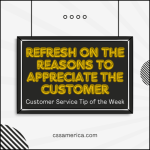
John Locke was a 17th century English philosopher, physician, and researcher. He wrote many papers arguing particular points, oftentimes using reason and facts as the basis for his position. He noted that many disagreements start because there is – in my words – a lack of real clarity about the topic of discussion.
He often liked to start discussions on some pertinent topic by defining key words. In essence, his position was: Let’s make sure we’re talking about the same thing before we start talking about it.
For those of us working in the customer service world, communication is the source of many issues, and disagreements are especially frustrating when we are miscommunicating about the topic itself. Here are some examples of topics that the customer wants to discuss, topics that need to be defined first:
- The customer can’t register.
- Did they mean register or apply? Are they registering a device or an account or for a class? Is it for them personally or a product they just bought?
- The customer wants to talk about their account.
- Is it really about the account, or is it a login issue to the online account? Is it something regarding an account or an order? Is it about an e-mail they received about their account? Is it something odd on a recent account statement?
- The customer has a question about their property listing.
- Is it some misinformation online regarding their property, or are they looking at a property assessment hardcopy? Is it about their property card online or how it’s noted in the MLS?
- The season ticket holder has a question about payment plans.
- Is it a true “payment plan,” or are they just asking about different ways to pay? Are they concerned with options, progress, terms, how to pay off, or how to cancel?
To avoid unnecessary conflicts and address needs and issues more quickly, ensure your definition matches the customer’s definition.
Locke in a common definition of the topic from the start.
Signup for FREE Tips! Contact Us More Resources for You Visit Our Home Page














 Here are 3 customer service scenarios for a college IT department:
Here are 3 customer service scenarios for a college IT department: A recent article in The Charlotte Observer got me thinking about a concept, a premise that is suggested all too often in society. First, the article: The story was about lawn care, and some of the people quoted in the article talked about what customers want today. They noted how customers want to be good stewards of the environment, they want sustainable solutions, they want to protect pollinators like bees, and they want pesticides used with discretion.
A recent article in The Charlotte Observer got me thinking about a concept, a premise that is suggested all too often in society. First, the article: The story was about lawn care, and some of the people quoted in the article talked about what customers want today. They noted how customers want to be good stewards of the environment, they want sustainable solutions, they want to protect pollinators like bees, and they want pesticides used with discretion.






